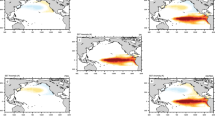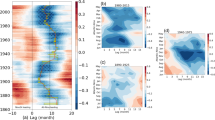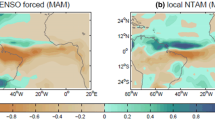Abstract
El Niño Southern Oscillation (ENSO) impact on the North Atlantic European sector (NAE) is still under discussion. Recent studies have found a non stationary feature of this teleconnection, suggesting an effective modulating role of the ocean mean state. Nevertheless, physical explanations about the underlying mechanisms have been little studied in the available literature. In addition, ENSO events show different SST spatial patterns, phases, and amplitudes, which can also influence on the related remote impacts. In view of all this, in the present study a set of partially coupled experiments have been performed with a global atmospheric general circulation model in which different SST ENSO patterns are superimposed over distinct Pacific and Atlantic SST mean states. These SST background conditions are constructed according to the observational difference between periods with a distinct impact of ENSO on the leading Euro-Mediterranean rainfall mode in late winter-early spring. Our results point to two distinct mechanisms associated with ENSO that can be modulated by the SST mean state: (1) the thermally driven direct circulation (Walker and Hadley cells) connecting the Atlantic and Pacific basins, and (2) the Rossby wave propagation from the tropical Pacific to the North Atlantic. The former elucidates that the positive NAO-like pattern usually related to La Niña events could be only valid for selected decades. The latter explains a reinforced signature of Eastern Pacific Niños on the Euro-Mediterranean rainfall when the tropical Pacific is warmer than usual and the North Atlantic is colder than usual. This feature is consistent with the changing ENSO impact identified in previous studies and demonstrates how the ENSO teleconnection with the NAE climate at interannual timecales could be modulated by multidecadal changes in the SST. According to our results, the assumption of stationarity which is still common to many studies of ENSO teleconnections clearly has to be questioned.








Similar content being viewed by others
References
Ambrizzi T, Hoskins BJ, Hsu HH (1995) Rossby wave propagation and teleconnection patterns in the austral winter. J Atmos Sci 52:3661–3672. doi:10.1175/1520-0469(1995)0523661:RWPATP2.0.CO;2
Barnston A, Livezey R (1987) Classification, seasonality and persistence of low-frequency atmospheric circulation patterns. Mon Weather Rev 115:1083. doi:10.1175/1520-0493(1987)1151083:CSAPOL2.0.CO;2
Bi D, Dix M, Marsland SJ, OFarrell S, Rashid H, Uotila P, Hirst A, Kowalczyk E, Golebiewski M, Sullivan A et al (2013) The access coupled model: description, control climate and evaluation. Aust Meteorol Oceanogr J 63(1):41–64
Bladé I, Newman M, Alexander MA, Scott JD (2008) The late fall extratropical response to ENSO: sensitivity to coupling and convection in the Tropical West Pacific. J Clim 21:6101. doi:10.1175/2008JCLI1612.1
Branstator G (2002) Circumglobal teleconnections, the jet stream waveguide, and the North Atlantic oscillation. J Clim 15:1893–1910. doi:10.1175/1520-0442(2002)0151893:CTTJSW2.0.CO;2
Brönnimann S (2007) Impact of El Niño–Southern Oscillation on European climate. Rev Geophys 43:RG3003. doi:10.1029/2006RG000199
Bulić IH, Kucharski F (2012) Delayed ENSO impact on spring precipitation over North/Atlantic European region. Clim Dyn 38(11–12):2593–2612
Cassou C, Terray L (2001) Oceanic forcing of the wintertime low-frequency atmospheric variability in the North Atlantic European sector: a study with the ARPEGE model. J Clim 14:4266–4291. doi:10.1175/1520-0442(2001)0144266:OFOTWL2.0.CO;2
Choi J, An SI, Kug JS, Yeh SW (2011) The role of mean state on changes in El Niño’s flavor. Clim Dyn 37:1205–1215. doi:10.1007/s00382-010-0912-1
Compo GP, Whitaker JS, Sardeshmukh PD, Matsui N, Allan RJ, Yin X, Gleason BE, Vose RS, Rutledge G, Bessemoulin P, Brönnimann S, Brunet M, Crouthamel RI, Grant AN, Groisman PY, Jones PD, Kruk MC, Kruger AC, Marshall GJ, Maugeri M, Mok HY, Nordli Ø, Ross TF, Trigo RM, Wang XL, Woodruff SD, Worley SJ (2011) The twentieth century reanalysis project. Quart J Roy Meteor Soc 137:1–28. doi:10.1002/qj.776
Davies T, Cullen M, Malcolm A, Mawson M, Staniforth A, White A, Wood N (2005) A new dynamical core for the Met Office’s global and regional modelling of the atmosphere. Quart J Roy Meteor Soc 131(608):1759–1782
Dommenget D (2010) The slab ocean El Niño. Geophys Res Lett 37:L20701. doi:10.1029/2010GL044888
Dommenget D, Latif M (2002) Analysis of observed and simulated SST spectra in the midlatitudes. Clim Dyn 19:277–288. doi:10.1007/s00382-002-0229-9
Dommenget D, Bayr T, Frauen C (2013) Analysis of the non-linearity in the pattern and time evolution of El Niño southern oscillation. Clim Dyn 40:2825–2847. doi:10.1007/s00382-012-1475-0
Dong B, Sutton RT, Scaife AA (2006) Multidecadal modulation of El Niño–Southern Oscillation (ENSO) variance by Atlantic Ocean sea surface temperatures. Geophys Res Lett 33:L08705. doi:10.1029/2006GL025766
Fraedrich K, Müller K (1992) Climate anomalies in Europe associated with ENSO extremes. Int J Climatol 12:25–31. doi:10.1002/joc.3370120104
Frauen C, Dommenget D (2010) El Niño and La Niña amplitude asymmetry caused by atmospheric feedbacks. Geophys Res Lett 37:L18801. doi:10.1029/2010GL044444
Frauen C, Dommenget D, Tyrrell N, Rezny M, Wales S (2014) Analysis of the nonlinearity of El Niño–Southern oscillation teleconnection. J Clim 27:6225. doi:10.1175/JCLI-D-13-00757.1
García-Serrano J, Rodríguez-Fonseca B, Bladé I, Zurita-Gotor P, de La Cámara A (2011) Rotational atmospheric circulation during North Atlantic-European winter: the influence of ENSO. Clim Dyn 37:1727–1743. doi:10.1007/s00382-010-0968-y
Gill AE (1980) Some simple solutions for heat-induced tropical circulation. Quart J Roy Meteor Soc 106:447–462. doi:10.1002/qj.49710644905
Gouirand I, Moron V (2003) Variability of the impact of El Niño–Southern oscillation on sea-level pressure anomalies over the North Atlantic in January to March (1874–1996). Int J Climatol 23:1549–1566. doi:10.1002/joc.963
Graham NE, Barnett TP (1987) Sea surface temperature, surface wind divergence, and convection over tropical oceans. Science 238:657–659. doi:10.1126/science.238.4827.657
Greatbatch RJ, Lu J, Peterson KA (2004) Nonstationary impact of ENSO on Euro-Atlantic winter climate. Geophys Res Lett 31:L02208. doi:10.1029/2003GL018542
Ham YG, Sung MK, An SI, Schubert SD, Kug JS (2014) Role of tropical atlantic SST variability as a modulator of El Niño teleconnections. Asia Pac J Atmos Sci 50:247–261. doi:10.1007/s13143-014-0013-x
Honda M, Nakamura H, Ukita J, Kousaka I, Takeuchi K (2001) Interannual seesaw between the Aleutian and icelandic lows. Part I: seasonal dependence and life cycle. J Clim 14:1029–1042. doi:10.1175/1520-0442(2001)0141029:ISBTAA2.0.CO;2
Hoskins BJ, Ambrizzi T (1993) Rossby wave propagation on a realistic longitudinally varying flow. J Atmos Sci 50:1661–1671. doi:10.1175/1520-0469(1993)0501661:RWPOAR2.0.CO;2
Hoskins BJ, Karoly DJ (1981) The steady linear response of a spherical atmosphere to thermal and orographic forcing. J Atmos Sci 38:1179–1196. doi:10.1175/1520-0469(1981)0381179:TSLROA2.0.CO;2
Kang IS, Kug JS (2002) El Niño and La Niña sea surface temperature anomalies: asymmetry characteristics associated with their wind stress anomalies. J Geophys Res Atmos 107:4372. doi:10.1029/2001JD000393
Kang IS, No H, Kucharski F (2014) ENSO amplitude modulation associated with the mean SST changes in the tropical central Pacific induced by atlantic multidecadal oscillation. J Clim 27:7911–7920. doi:10.1175/JCLI-D-14-00018.1
Kao HY, Yu JY (2009) Contrasting eastern-Pacific and central-Pacific types of ENSO. J Clim 22:615. doi:10.1175/2008JCLI2309.1
Karoly DJ, Plumb RA, Ting M (1989) Examples of the horizontal propagation of quasi-stationary waves. J Atmos Sci 46:2802–2811. doi:10.1175/1520-0469(1989)0462802:EOTHPO2.0.CO;2
Knight JR, Allan RJ, Folland CK, Vellinga M, Mann ME (2005) A signature of persistent natural thermohaline circulation cycles in observed climate. Geophys Res Lett 32:L20708. doi:10.1029/2005GL024233
Knippertz P, Ulbrich U, Marques F, Corte-Real J (2003) Decadal changes in the link between El Niño and springtime North Atlantic oscillation and European-North African rainfall. Int J Climatol 23:1293–1311. doi:10.1002/joc.944
Kucharski F, Ikram F, Molteni F, Farneti R, Kang IS, No HH, King M, Giuliani G, Mogensen K (2015) Atlantic forcing of Pacific decadal variability. Clim Dyn. doi:10.1007/s00382-015-2705-z
Kug JS, Jin FF, An SI (2009) Two types of El Niño events: cold tongue El Niño and warm pool El Niño. J Clim 22:1499. doi:10.1175/2008JCLI2624.1
Livezey RE, Mo KC (1987) Tropical-extratropical teleconnections during the Northern Hemisphere winter. Part II: Relationships between monthly mean Northern Hemisphere circulation patterns and proxies for tropical convection. Mon Weather Rev 115:3115. doi:10.1175/1520-0493(1987)115<3115:TETDTN>2.0.CO;2
López-Parages J, Rodríguez-Fonseca B (2012) Multidecadal modulation of El Niño influence on the Euro-Mediterranean rainfall. Geophys Res Lett 39:L02704. doi:10.1029/2011GL050049
López-Parages J, Rodríguez-Fonseca B, Terray L (2014) A mechanism for the multidecadal modulation of ENSO teleconnection with Europe. Clim Dyn 45(3–4):867–880. doi:10.1007/s00382-014-2319-x
Mantua NJ, Hare SR, Zhang Y, Wallace JM, Francis RC (1997) A Pacific interdecadal climate oscillation with impacts on salmon production. Bull Am Meteor Soc 78:1069–1079. doi:10.1175/1520-0477(1997)0781069:APICOW2.0.CO;2
Mariotti A, Zeng N, Lau KM (2002) Euro-Mediterranean rainfall and ENSO—a seasonally varying relationship. Geophys Res Lett 29:1621. doi:10.1029/2001GL014248
Martin G, Bellouin N, Collins W, Culverwell I, Halloran P, Hardiman S, Hinton T, Jones C, McDonald R, McLaren A et al (2011) The HadGEM2 family of met office unified model climate configurations. Geosci Model Dev Discuss 4:765–841
Martin GM, Milton SF, Senior CA, Brooks ME, Ineson S, Reichler T, Kim J (2010) Analysis and reduction of systematic errors through a seamless approach to modeling weather and climate. J Clim 23:5933–5957. doi:10.1175/2010JCLI3541.1
Mathieu PP, Sutton RT, Dong B, Collins M (2004) Predictability of winter climate over the North Atlantic European region during ENSO events. J Clim 17:1953–1974. doi:10.1175/1520-0442(2004)0171953:POWCOT2.0.CO;2
Mo KC, Livezey RE (1986) Tropical-extratropical geopotential height teleconnections during the Northern Hemisphere winter. Mon Weather Rev 114:2488. doi:10.1175/1520-0493(1986)1142488:TEGHTD2.0.CO;2
Moron V, Gouirand I (2003) Seasonal modulation of the El Niño–Southern oscillation relationship with sea level pressure anomalies over the North Atlantic in October–March 1873–1996. Int J Climatol 23:143–155. doi:10.1002/joc.868
Moron V, Plaut G (2003) The impact of El Niño--Southern oscillation upon weather regimes over Europe and the North Atlantic during boreal winter. Int J Climatol 23:363–379. doi:10.1002/joc.890
Murphy JM, Sexton DMH, Barnett DN, Jones GS, Webb MJ, Collins M, Stainforth DA (2004) Quantification of modelling uncertainties in a large ensemble of climate change simulations. Nature 430:768–772. doi:10.1038/nature02771
Peng S, Whitaker JS (1999) Mechanisms determining the atmospheric response to midlatitude SST anomalies. J Clim 12:1393–1408. doi:10.1175/1520-0442(1999)0121393:MDTART2.0.CO;2
Philip S, van Oldenborgh GJ (2009) Significant atmospheric nonlinearities in the ENSO cycle. J Clim 22:4014. doi:10.1175/2009JCLI2716.1
Pozo-Vázquez D, Esteban-Parra MJ, Rodrigo FS, Castro-Díez Y (2001) The association between ENSO and winter atmospheric circulation and temperature in the North Atlantic region. J Clim 14:3408–3420. doi:10.1175/1520-0442(2001)0143408:TABEAW2.0.CO;2
Pozo-Vázquez D, Gámiz-Fortis SR, Tovar-Pescador J, Esteban-Parra MJ, Castro-Díez Y (2005a) El Niño–Southern oscillation events and associated European winter precipitation anomalies. Int J Climatol 25:17–31. doi:10.1002/joc.1097
Pozo-Vázquez D, Gámiz-Fortis SR, Tovar-Pescador J, Esteban-Parra MJ, Castro-Díez Y (2005b) North Atlantic winter SLP anomalies based on the autumn ENSO state. J Clim 18:97–103. doi:10.1175/JCLI-3210.1
Quadrelli R, Wallace JM (2002) Dependence of the structure of the Northern Hemisphere annular mode on the polarity of ENSO. Geophys Res Lett 29:2132. doi:10.1029/2002GL015807
Rayner NA, Parker DE, Horton EB, Folland CK, Alexander LV, Rowell DP, Kent EC, Kaplan A (2003) Global analyses of sea surface temperature, sea ice, and night marine air temperature since the late nineteenth century. J Geophys Res Atmos 108:4407. doi:10.1029/2002JD002670
Ruiz-Barradas A, Carton JA, Nigam S (2003) Role of the atmosphere in climate variability of the tropical atlantic. J Clim 16:2052–2065. doi:10.1175/1520-0442(2003)0162052:ROTAIC2.0.CO;2
Sung MK, Ham YG, Kug JS, An SI (2013) An alterative effect by the tropical north atlantic SST in intraseasonally varying EL Nino teleconnection over the North Atlantic. Tellus 65. doi:10.3402/tellusa.v65i0.19863
Sutton RT, Hodson DLR (2003) Influence of the ocean on North Atlantic Climate Variability 1871–1999. J Clim 16:3296–3313. doi:10.1175/1520-0442(2003)0163296:IOTOON2.0.CO;2
Takaya K, Nakamura H (2001) A formulation of a phase-independent wave-activity flux for stationary and migratory quasigeostrophic eddies on a zonally varying basic flow. J Atmos Sci 58:608–627. doi:10.1175/1520-0469(2001)0580608:AFOAPI2.0.CO;2
Toniazzo T, Scaife A (2006) The influence of ENSO on winter North Atlantic climate. Geophys Res Lett 33:L24704. doi:10.1029/2006GL027881
Trenberth KE, Paolino DA (1980) The Northern Hemisphere sea-level pressure data set: trends errors and discontinuities. Mon Weather Rev 108:855. doi:10.1175/1520-0493(1980)855:TNHSLP2.0.CO;2
Trenberth KE, Branstator GW, Karoly D, Kumar A, Lau NC, Ropelewski C (1998) Progress during TOGA in understanding and modeling global teleconnections associated with tropical sea surface temperatures. J Geophys Res 103(14):291. doi:10.1029/97JC01444
Wang C (2002) Atlantic climate variability and its associated atmospheric circulation cells. J Clim 15:1516–1536. doi:10.1175/1520-0442(2002)0151516:ACVAIA2.0.CO;2
Wang C (2002) Atmospheric circulation cells associated with the El Niño–Southern Oscillation. J Clim 15:399–419. doi:10.1175/1520-0442(2002)0150399:ACCAWT2.0.CO;2
Wang C, Enfield DB (2003) A further study of the tropical Western Hemisphere warm pool. J Clim 16:1476–1493. doi:10.1175/1520-0442-16.10.1476
Wang C, Picaut J (2004) Understanding ENSO physics: a review. AGU Geophys Monogr Ser 147:21–48. doi:10.1029/147GM02
Washington WM, Meehl GA (1984) Seasonal cycle experiment on the climate sensitivity due to a doubling of CO\(_{2}\) with an atmospheric general circulation model coupled to a simple mixed-layer ocean model. J Geophys Res 89:9475–9503. doi:10.1029/JD089iD06p09475
Wilks DS (2011) Statistical methods in the atmospheric sciences, vol 100. Academic Press, London
Wu A, Hsieh WW (2004) The nonlinear association between ENSO and the Euro-Atlantic winter sea level pressure. Clim Dyn 23:859–868. doi:10.1007/s00382-004-0470-5
Zhang Y, Wallace JM, Battisti DS (1997) ENSO-like interdecadal variability: 1900–93. J Clim 10:1004–1020. doi:10.1175/1520-0442(1997)0101004:ELIV2.0.CO;2
Acknowledgments
This work was supported by the National Spanish projects: TRACS (CGL2009-10285) and MULCLIVAR (CGL2012-38923-C02-01). In particular, J.L.P. thanks the FPI Grant (BES-2010-042234) associated with TRACS project. J.L.P. also thanks the Monash Weather and Climate group of Monash University (Melbourne) for scientific discussions and incredible hospitality. The sensitivity experiments described in this paper were performed on Monash University.
Author information
Authors and Affiliations
Corresponding author
Additional information
An erratum to this article can be found at http://dx.doi.org/10.1007/s00382-016-3084-9.
Electronic supplementary material
Below is the link to the electronic supplementary material.
Rights and permissions
About this article
Cite this article
López-Parages, J., Rodríguez-Fonseca, B., Dommenget, D. et al. ENSO influence on the North Atlantic European climate: a non-linear and non-stationary approach. Clim Dyn 47, 2071–2084 (2016). https://doi.org/10.1007/s00382-015-2951-0
Received:
Accepted:
Published:
Issue Date:
DOI: https://doi.org/10.1007/s00382-015-2951-0




